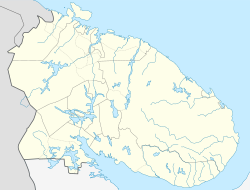Pechenga
| Urban-type settlement
Pecheng
Pechenga
|
||||||||||||||||||||||||||||||||
|
||||||||||||||||||||||||||||||||
|
||||||||||||||||||||||||||||||||
Petschenga ( Russian Печенга , Finnish Petsamo , North Sami Beahcán, Skoltsamisch Peäccam) is an urban-type settlement in the far northwest of Russia with 3188 inhabitants (as of October 14, 2010). The Petschenga area borders Finland and Norway in the west and a fjord of the Barents Sea in the north . The place is 6 km south of the end of the Petschengafjord , which reaches the Barents Sea after a further 17 km northeast.
history

The first known residents of the area were Skolt seeds .
Pechenga was ceded by Bolshevik Russia to the now independent Finland in the Peace of Dorpat in 1920 . For a short time it formed its own province until it was attached to the province of Lapland in 1921 . Pecheng became important for Finland because the place Liinahamari (Russian Liinachamari / Лииинахамари) was the only year-round ice-free port in the country thanks to the Gulf Stream . However, Finland was unable to ship any significant freight through this port because there was no connection to the state rail network. However, the place became a popular tourist destination.
Large nickel deposits were discovered in the region in 1924, and from 1934 onwards Finland commissioned English, Canadian and French companies to mine them.
In early 1940, the Red Army occupied the area during the Winter War , which the Soviet Union, with the exception of the fishing peninsula (Kalastajansaarento), vacated after the peace of Moscow . On August 12, 1940, the USS American Legion (APA-17) evacuated 897 people, mostly US citizens, from Scandinavia and the Baltic States to New York City , including Victor Borge , Eveline von Maydell and the Norwegian Crown Princess Märtha .
In the war against the Soviet Union , Petsamo was an important hub for supplying the Wehrmacht and an important base for the Air Force ( Arctic Ocean Fighters , especially Jagdgeschwader 5 ). Murmansk was repeatedly attacked from Petsamo by the Air Force, Wehrmacht and Finnish units. The extremely impassable terrain, however, allowed almost exclusively air attacks, especially on the strategically extremely important Murman Railway to Moscow , through which the supplies of the northern sea convoys were transported from the port of Murmansk to the combat area of Central Russia.
In the Moscow armistice of September 19, 1944, Finland had to cede Petschenga to the Soviet Union. At the Paris Peace Conference in 1946 , the Soviet Union was also assigned the area of Jäniskoski from the municipality of Inari .
Heavy industry has expanded significantly since then, which has resulted in the region's soil and groundwater being highly contaminated today. During the Soviet era, Pechenga was closed to foreigners as the northern fleet around Murmansk concentrated the world's largest nuclear arsenal.
Nearby is the German Parkkina / Petschenga military cemetery, where 5705 soldiers are buried.
Population development
| year | Residents |
|---|---|
| 1959 | 3458 |
| 1970 | 2576 |
| 1979 | 2084 |
| 1989 | 2671 |
| 2002 | 2959 |
| 2010 | 3188 |
Note: census data
Sons and daughters of the place
- Andrei Monastyrski (* 1949), Russian artist and author
- Maila Nurmi (1921–2008), American actress
- Erno Paasilinna (1935–2000), Finnish author and journalist
Web links
- Pechenga's unofficial website (Russian)
Individual evidence
- ↑ a b Itogi Vserossijskoj perepisi naselenija 2010 goda. Tom 1. Čislennostʹ i razmeščenie naselenija (Results of the All-Russian Census 2010. Volume 1. Number and distribution of the population). Tables 5 , pp. 12-209; 11 , pp. 312–979 (download from the website of the Federal Service for State Statistics of the Russian Federation)




